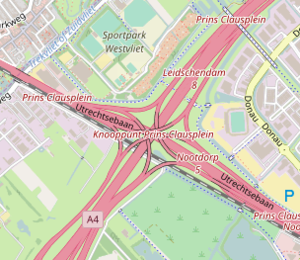Knooppunt Prins Clausplein
| Knooppunt Prins Clausplein | |
|---|---|
|
|
|
| map | |
| location | |
| Country: | Netherlands |
| Provinces : | Province of Zuid-Holland |
| Coordinates: | 52 ° 3 '44 " N , 4 ° 22' 33" E |
| Height: | 6 m above sea level NN |
| Basic data | |
| Design type: | Maltese cross |
| Bridges: | 5 (motorway) / 2 (other) |
| Construction year: | 1957 |
The Knooppunt Prins Clausplein is a motorway junction in the Dutch province of South Holland in the east of The Hague . It connects Rijksweg 4 (A4: Amsterdam - The Hague - Rotterdam - Bergen op Zoom ) with Rijksweg 12 (A12: Oberhausen - Arnhem - Utrecht - The Hague). It is the only motorway junction in the Netherlands that was built entirely as a Maltese junction.
The knot is named after Claus von Amsberg (better known as Prince Claus, Dutch Prins Claus), the former prince consort of the Dutch Queen Beatrix , who died in October 2002. At the time, it was the first motorway junction in the Netherlands that was named after a living person. The appendix plein comes from the time when the junction was still a roundabout (Dutch Verkeersplein). Before the knot got its current name in 1985, it was called Knooppunt Leidschendam .
history
Verkeersplein Leidschendam
The junction was opened to traffic on August 31, 1957 as Knooppunt Leidschendam with the opening of the A4 between Knooppunt Ypenburg and Knooppunt Leidschendam. Construction of the section had already started in the 1940s, but the work had to be temporarily suspended during the Second World War and was only resumed in 1954. As early as April 15, 1937, the A12 was completed in the area of the junction and a few years later it was extended further east to Gouda. Half a year later the A4 was completed on February 11, 1958 north of the junction as far as Hoogmade and connected to the junction in the form of a roundabout.
Knooppunt Prins Clausplein
In 1983 the A12 was expanded to six lanes at the cross. In the 1980s, however, it turned out that the roundabout was no longer able to cope with the increasing volume of traffic and that a node with a higher capacity was needed. In the following years, the junction was converted into a Maltese cross-shaped motorway junction and opened under a new name on June 20, 1985.
In 1998, the network south of the junction in front of the Knooppunt Ypenburg and the resulting parallel carriageway was opened and later expanded in 1999 so that the A4 has ten lanes in the area. In 2005 the speed limit on the A12 in The Hague and up to the Knooppunt Prins Clausplein was reduced to 80 km / h, before it was increased again to 100 km / h in 2012 out of town.
Design
The motorway junction is built as a complete Maltese junction and is the only one of its type in the Netherlands and one of few in Europe. The cross consists of four layers. The A12 runs on the bottom layer and the A4 above. On the third level are the semi-direct connecting ramps from Amsterdam to Utrecht and from Rotterdam to The Hague. On the top level are the semi-direct connecting ramps from The Hague to Amsterdam and from Utrecht to Rotterdam.
To the south and north of the junction, the A4 has a parallel lane to Knooppunt Ypenburg and to the Leidschendam exit. In the south of the junction, a network can be used to switch between the main and parallel lanes. The A12 has no parallel carriageway in the area of the intersection, but there is six lanes. The connecting ramps from Rotterdam in the direction of The Hague and Utrecht and from The Hague and Utrecht to Rotterdam are each two-lane, the remaining one-lane each.
The cross is completely surrounded by built-up area. To the north lies the community Leidschendam , in the east of The Hague district Leidschenveen and located in the south the districts of Ypenburg and Nootdorp . In the south, the Gouda – The Hague line runs parallel and at the same height as the A12 through the junction, which is crossed by a total of 5 bridges.
Web links
Individual evidence




